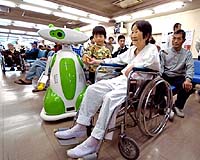 |
Washington (AFP) Aug 11, 2009 As pilotless US drones do battle from the sky in Afghanistan, Pakistan and Iraq, a top US Army general is urging the military to step up the deployment of unmanned vehicles on the ground. "It's all about saving lives," said Lieutenant General Rick Lynch, the commander of the III Armored Corps and the holder of a master's degree in mechanical engineering from the Massachusetts Institute of Technology (MIT). "There's got to be a sense of urgency," Lynch told delegates on Tuesday at an exhibition here featuring manufacturers from around the world of unmanned ground, maritime, air and space systems. While serving in Iraq, Lynch said he lost a total of 153 soldiers under his command and "80 percent of those soldiers didn't have to die." "I am so tired of going to demonstrations of technology," he said. "The technology is there. We've got to get past the demonstrations and into the field." "If you're not fielding, you're failing," he said. The US military makes extensive use of unmanned drones against Taliban and Al-Qaeda militants in Afghanistan, Pakistan and Iraq both for surveillance and launching missile strikes. But ground operations are mostly limited to the use of small camera-equipped robots to detect improvised explosive devices, or IEDs. Lynch, who also commands Fort Hood, Texas, the largest US military base in the world, said aerial surveillance and weapons systems were useful but "the bad guys know that if the weather turns bad we can't see them from the air." He said among the "immediate applications" for unmanned vehicles were route clearance, surveillance and in convoys. "We're going to be fighting this war on terror for the next 10 years and the enemy's weapon of choice is the IED," he said. "It is today and it will be in the future." Lynch said unmanned vehicles exist which are "excellent at clearing routes," which can go from point A to point B and even detect and avoid obstacles. "Let's get those kids out of the vehicles," he said. The general said unmanned vehicles should also be deployed to carry out what he called "persistent stare." "The bad guys in Iraq and Afghanistan, they've got their favorite places where they want to place their IEDS," he said. When aerial surveillance is not available, "we watch those IED hotspots with human beings, which puts them at risk," he said. Unmanned robots can "watch these IED hotspots for extended periods of time ... and kill those bad guys before they can plant the IEDs," he said. Lynch said the technology exists to use unmanned vehicles in convoys, as lead or trailing vehicles, for example, cutting down on the number of drivers and the risks. "We're losing so many soldiers in convoys it's an embarrassment," he said. "Why does every vehicle have to be occupied by a human being?" He said an unmanned vehicle could also be used as a "robotic wingman" -- a fighting platform which mirrors the actions of a manned vehicle. Lynch invited participants in the exhibition, sponsored by the Association for Unmanned Vehicle Systems International (AUVSI), to attend a September 1-3 "Robotics Rodeo" that he is holding at Fort Hood. "Bring your systems to Fort Hood and allow the soldiers who just got back from combat to use them," he said. "They'll tell you 'This is going to work. I know that ain't going to work.'" Share This Article With Planet Earth
Related Links All about the robots on Earth and beyond!
 New robots help humans cope with illness
New robots help humans cope with illnessValencia, Spain (AFP) Aug 2, 2009 Robots that can cook, dance to Michael Jackson songs or guide the blind are among the gadgets aimed at helping humans cope with illnesses on display in Spain at one of the world's biggest annual gatherings of new technology enthusiasts. Standing 58 centimetres (23 inches) tall and with a plastic shell for a body, a humanoid robot called Nao drew a crowd at the Campus Party in Valencia as it ... read more |
|
| The content herein, unless otherwise known to be public domain, are Copyright 1995-2009 - SpaceDaily. AFP and UPI Wire Stories are copyright Agence France-Presse and United Press International. ESA Portal Reports are copyright European Space Agency. All NASA sourced material is public domain. Additional copyrights may apply in whole or part to other bona fide parties. Advertising does not imply endorsement,agreement or approval of any opinions, statements or information provided by SpaceDaily on any Web page published or hosted by SpaceDaily. Privacy Statement |